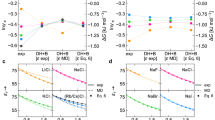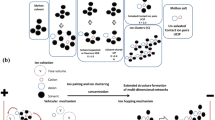Abstract
Mathematics is so common-place in modern physics and chemistry that one may not realise how controversial its admittance was to these fields in the eightieth and ninetieth centuries respectively. This paper deals with the controversy during the formation of physical chemistry as a discipline in the late ninetieth and early twentieth centuries and sketches more recent criticisms of the way mathematics has been used in solution chemistry. The controversy initially related particularly to electrolyte chemistry and its emerging use of mathematics to support Arrhenius’ theory of ionic dissociation. The impact of mathematics on the field is divided into three phases: that from 1880 to 1920 which was a period of heightened controversy; that from 1920 to 1990 which was a period of relative calm and mathematical development; and finally, that from 1990 to the present which has been a time of reflective criticism of the extensive use of empirical parameters in the emergent mathematics of the twentieth century. It is argued that the current solution to the criticism, as proposed by Heyrovska, is best viewed in the light of the historical development of the controversy.
Similar content being viewed by others
References
Armstrong, H.E.: Abstracts of the proceedings of the chemical society. Proc. Chem. Soc. Lond. 5(71), 105–126 (1889a)
Armstrong, H.E.: Report of the 58th meeting of the British Association for the Advancement of Science. John Murray, London (1889b)
Armstrong, H.E.: Annual general meeting. J. Chem. Soc. Trans. 67, 1105–1172 (1895)
Armstrong, H.E.: Osmotic pressure. Nature 74, 79 (1906)
Arrhenius, S.: Uber die Dissociation der in Wasser gelosten Stoffe. Z. Phys. Chem. 1, 631–648 (1887)
Arrhenius, S.: Electrolytic dissociation. J. Am. Chem. Soc. 34(4), 353–364 (1912)
Arrhenius, S.: The theory of electrolytic dissociation. J. Chem. Soc. Trans. 105, 1414–1426 (1914)
Atkins, P., De Paula, J.: Atkins’ Physical Chemistry, 9th edn. Oxford University Press, Oxford (2011)
Babcock, K.L.: Theory of chemical properties of soil colloidal systems at equilibrium. Hilgardia 34, 417–542 (1963)
Bronsted, J.N.: Studies on solubility IV. The principle of the specific interaction of ions. J. Am. Chem. Soc. 44(5), 877–898 (1922)
Bronsted, J.N.: The individual thermodynamic properties of ions. J. Am. Chem. Soc. 45(12), 2898–2910 (1923)
Darvell, B.W., Leung, V.W.H.: RIP ionic strength 1921–1991. Chem. Br. Jan., 29–30 (1991)
Dawson, H.M.: The validity of the ionisation theory. Nature 65(1688), 414–415 (1902)
De Berg, K.C.: The development of the theory of electrolytic dissociation: a case study of a scientific controversy and the changing nature of chemistry. Sci. Educ. 12, 397–419 (2003)
De Berg, K.C.: What happens when salt dissolves in water? An introduction to scientific argument and counter argument drawn from the history of science. Teach. Sci. 52(1), 24–27 (2006a)
De Berg, K.C.: The kinetic-molecular and thermodynamic approaches to osmotic pressure: a study of dispute in physical chemistry and the implications for chemistry education. Sci. Educ. 15, 495–519 (2006b)
De Berg, K.C.: Arrhenius and Armstrong: How active opponents in the history of chemistry became major contributors to modern electrolyte chemistry. Paper presented at the 8th international conference for the history of science in science education. Maresias, 16–19, Aug (2010)
De Berg, K.C.: Raoult’s law: a reinterpretation for concentrated strong 1:1 electrolyte solutions. Aust. J. Educ. Chem. 71, 15–18 (2011)
Dolby, R.G.A.: Debates over the theory of solution: a study of dissent in physical chemistry in the english-speaking world in the late nineteenth and early twentieth centuries. In: McCormmach, R. (ed.) Historical Studies in the Physical Sciences, pp. 297–404. Princeton University Press, Princeton NJ (1976)
Fitzgerald, G.F.: The Helmholtz memorial lecture. J. Chem. Soc. Trans. 69, 885–912 (1896)
Franks, F. (1991): Old habits die hard. Chem. Br. Apr., 315 (1991)
Gingras, Y.: What did mathematics do to physics? Hist. Sci. 39, 383–416 (2001)
Glasstone, S., Lewis, D.: Elements of Physical Chemistry, 2nd edn. Macmillan and Co., London (1963)
Guggenheim, E.A.: The specific thermodynamic properties of aqueous solutions of strong electrolytes. Philos. Mag. 19(7), 588–643 (1935)
Hamer, W.J., Wu, Y.: Osmotic coefficients and mean activity coefficients of uni-univalent electrolytes in water at 25°C. J. Phys. Chem. Ref. Data 1(4), 1047–1099 (1972)
Heyrovska, R.: A reappraisal of Arrhenius’ theory of partial dissociation of electrolytes. In: Stock, J.T., Orna, M.V. (eds.) Electrochemistry Past and Present, pp. 75–91. ACS publications, Washington (1989)
Heyrovska, R.: Ionic concentration outlives ionic strength. Chem. Br. Dec., 1114 (1991)
Heyrovska, R.: Physical electrochemistry of strong electrolytes based on partial dissociation and hydration. J. Electrochem. Soc. 143(6), 1789–1793 (1996)
Heyrovska, R.: A concise equation of state for aqueous solutions of electrolytes incorporating thermodynamic laws and entropy. Entropy 6, 128–132 (2004)
Heyrovska, R.: Ionic concentrations and hydration numbers of supporting electrolytes. Electroanalysis 18(4), 351–361 (2006)
Heyrovska, R.: Arrhenius’ theory of partial dissociation and hydration completely replace existing ideas of activity and complete dissociation of electrolytes in solutions. Curr. Top. Electrochem. 16, 47–56 (2011)
Heyrovska, R.: Solution phase thermodynamics of strong electrolytes based on ionic concentrations, hydration numbers and volumes of dissolved entities. Struct. Chem. (2013). doi:10.1007/s11224-013-0256-7
Hunter, R.J.: Foundations of Colloid Science, 1st edn. Clarendon Press, Oxford (1987)
Kahlenberg, L.: The theory of electrolytic dissociation as viewed in the light of facts recently ascertained. J. Phys. Chem. 5, 339–392 (1901)
Kahlenberg, L.: On the nature of the process of osmosis and osmotic pressure with observations concerning dialysis. J. Phys. Chem. 10(3), 141–209 (1905a)
Kahlenberg, L.: Recent investigations bearing on the theory of electrolytic dissociation. Trans. Faraday Soc. 1, 42–53 (1905b)
Kahlenberg, L.: Osmotic studies (Reply to Ernst Cohen and J.W. Commelin). J. Phys. Chem. 13(2), 93–113 (1908)
Lewis, G.N., Randall, M.: The activity coefficient of strong electrolytes. J. Am. Chem. Soc. 43(5), 1112–1154 (1921)
Lewis, G.N., Randall, M.: Thermodynamics, 2nd edn. McGraw Hill, New York (1961)
Lodge, O.: Introductory address on osmotic pressure. Trans. Faraday Soc. 13, 120–122 (1917)
Mysels, K.J.: Solvent tension or solvent dilution. J. Chem. Ed. 55(1), 21–22 (1978)
Mysels, K.J.: Vapor pressure lowering, osmotic pressure, and the elementary pseudo-gas model. J. Phys. Chem. 101, 1893–1896 (1997)
Pincock, C.: Mathematics and Scientific Representation. Oxford University Press, USA (2012)
Pitzer, K.S.: Thermodynamics, 3rd edn. McGraw Hill, New York (1995)
Pitzer, K.S., Mayorga, G.: Thermodynamics of electrolytes II: activity and osmotic coefficients for strong electrolytes with one or both ions univalent. J. Phys. Chem. 77, 2300–2308 (1973)
Pitzer, K.S., Mayorga, G.: Corrections. J. Phys. Chem. 78, 2698 (1974)
Ramsay, W.: Proceedings of the chemical society. Proc. Chem. Soc. Lond. 6(90), 169–178 (1890)
Robinson, R.A., Stokes, R.H.: Electrolyte Solutions, 2 revised edn. Dover Publications, Mineola (2002)
Servos, J.W.: Physical Chemistry from Ostwald to Pauling: The Making of a science in America. Princeton University Press, Princeton (1990)
Tilden, W.A.: Sir William Ramsay: Memorials of his Life and Work. Macmillan and Co., London (1918)
Tinker, F.: The colloidal membrane: its properties and its function in the osmotic system. Trans. Faraday Soc. 13, 133–140 (1917)
Van’t Hoff, J.H.: L’equilibre chimique dans les systemes gazeux ou dissous. Arch. neerlandaises des Sc. Exact. et Natur. 20, 239–302 (1886)
Van’t Hoff, J.H.: Die Rolle des Osmotischen Druckes in der Analogie zwischen Losungen und gasen. Z. Phys. Chem. 1, 481–508 (1887) (In: Jones, H.C. (ed.) The Modern Theory of Solutions, pp. 11–43. Harper and Bros., New York (1899))
Whetham, W.C.D.: The Theory of Dissociation into Ions. Nature 55(1435), 606–607 (1897)
Whetham, W.C.D.: Report of the 67th meeting of the British Association for the Advancement of Science, pp. 244–245. John Murray, London (1898)
Author information
Authors and Affiliations
Corresponding author
Rights and permissions
About this article
Cite this article
de Berg, K.C. Foundations of and challenges to electrolyte chemistry. Found Chem 17, 33–48 (2015). https://doi.org/10.1007/s10698-015-9219-y
Published:
Issue Date:
DOI: https://doi.org/10.1007/s10698-015-9219-y




